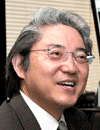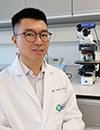Co-Located Conference AgendasFlow Chemistry Asia 2024 | Lab-on-a-Chip, Microfluidics, & Organ-on-a-Chip Asia 2024 | 

Thursday, 7 November 202408:00 | Conference Registration, Materials Pick-Up, Coffee, Tea and Networking in Exhibit Hall (Banquet Room Ozora) | |
Conference Plenary Session Chaired by: Professor Lydia Sohn and Professor Noah Malmstadt |
| | |
Venue: Tsuru A |
| | 09:00 |  | Keynote Presentation Nanobiodevices and Quantum Life Science for Future Healthcare
Yoshinobu Baba, Professor, Nagoya University, Japan
We have investigated nanobiodevices and quantum life science for biomedical applications and healthcare. Nanowire devices are extremely useful to isolate extracellular vesicles from body fluids and vesicle-encapsulated microRNA analysis. The device composed of a microfluidic substrate with anchored nanowires gives us highly efficient collections of extracellular vesicles in body fluids and in situ extraction for huge numbers of miRNAs (2,500 types) more than the conventional ultracentrifugation method. Nanowire devices gave us the miRNA date for several hundred patients and machine learning system based on these miRNA data enabled us to develop the early-stage diagnosis for lung cancer, brain tumor, pancreas cancer, liver cancer, bladder cancer, prostate cancer, diabetes, heart diseases, and Parkinson disease. We succeeded to identify high-grade serous ovarian carcinoma-specific extracellular vesicles by polyketone-coated nanowires and the spatial exosome analysis using cellulose nanofiber sheets to reveal the location heterogeneity of extracellular vesicles. Nanowire-nanopore devices combined with AI (machine learning technique) enable us to develop mobile sensors for SARS-CoV-2, PM2.5, bacteria, and virus in the environment. Nanopore sensing is applied to the identification of viral vector characteristics with the sub-nm resolution. MEXT Quantum Leap Flagship Program (Q-LEAP), which I lead, has been developing biological nano quantum sensors, quantum technology-based MRI/NMR, and quantum biology and biotechnology. Nanodiamonds, with nitrogen-vacancy centers (NVC), and quantum dots are applied to develop quantum sensors for quantum switching intra vital imaging for iPS cell based regenerative medicine, and quantum photo immuno-therapeutic devices for cancer. Nanodiamond with NVC is applied to in situ measurements of intracellular thermal conductivity and implication of thermal signaling in neuronal differentiation revealed by manipulation and measurement of intracellular temperature. |
| 09:30 |  | Keynote Presentation Title to be Confirmed -- Overview of the Organ-on-a-Chip Field
Nancy Allbritton, Frank and Julie Jungers Dean of the College of Engineering and Professor of Bioengineering, University of Washington in Seattle, United States of America
|
| 10:00 |  | Keynote Presentation Fabrication of Engineered Lipid Nanoparticles Using Microfluidic Devices
Manabu Tokeshi, Professor, Hokkaido University, Japan
Recently, the production of lipid nanoparticles (LNPs) using microfluidic devices has attracted much attention. Microfluidic devices provide many advantages for drug-loaded LNP production, including precise LNP size controllability, high reproducibility, high-throughput optimization of LNP formulation, and continuous LNP-production processes. Various microfluidic devices have been developed and used to produce LNPs encapsulating RNA, DNA, ribonucleoproteins (RNPs), drugs, and others. In fact, microfluidic devices are also being used in the development of Onpattro®, which was approved by the FDA in 2018 as an RNA interference therapeutic drug. Recently, we developed a microfluidic device named iLiNP® (invasive lipid nanoparticle production) device for LNP production based on computational fluid dynamics and LNP formation mechanism. It enabled the LNP size tuning at 10 nm intervals in the size range from 20 to 100 nm. Using this device, we have not only developed pharmaceutical applications by producing LNPs encapsulating nucleic acids and drugs, but also devices integrating the post-processing of LNP production and devices for mass production. Moreover, very recently, we have found that iLiNP devices are also highly suitable for the fabrication of functional (engineered) lipid nanoparticles such as artificial exosomes and virus-like particles. In this lecture I will present these results. |
| 10:30 | Mid-Morning Coffee Break and Networking with Exhibitors, Colleagues and View Posters | 11:00 |  | Keynote Presentation Microfluidic Platforms for Immunotherapy and Genome Editing
Aram Chung, Professor, School of Biomedical Engineering, Korea University, Korea South
The internalization of biomolecules in cells, such as DNAs, RNAs, plasmid DNAs, proteins, and CRISPR systems, is an indispensable process for studies ranging from basic biology to clinical applications. Tools such as viral vectors, cationic lipids, and electroporators have traditionally been used to deliver external biomolecules into cells; however, they are suboptimal for achieving high levels of delivery while preserving cell viability, phenotype, and function.
To address these challenges, our research group is focusing on developing next-generation microfluidics-based intracellular delivery platforms. By leveraging intrinsic fluid-cell interactions within confined microchannels, we create transient discontinuities on the cell membrane, internalizing external biomolecules into the cells. Using this principle, we have successfully demonstrated highly effective biomolecule delivery into various cells, including human primary stem and immune cells with high cell stability. In this talk, I will discuss our recent microfluidic intracellular delivery platform developments and their promising applications in genome editing and cancer immunotherapy. |
| 11:30 |  | Keynote Presentation Innovative Applications of Lipids and Microfluidics: Tools for Advanced Drug Delivery Systems and Biosensing
Tae-Joon Jeon, Professor, Inha University, Korea South
This seminar will explore the use and potential of biomimetic membranes and their derivatives in various scientific and engineering applications. These membranes have potential as drug delivery platforms and biosensing technologies. In addition, the integration of functional membrane proteins into these biomimetic constructs has opened up opportunities for engineering applications. This talk will highlight our groundbreaking work with biomimetic membranes, including innovative applications such as drug delivery systems, aquaporin-based water purification technology, and biosensing applications. Of particular interest, our research introduces a novel drug delivery platform called "vesosomes" or "peas-in-a-pod". These liposomes have multiple compartments that allow for controlled and sustained release of contents. In addition, we will present how microfluidic systems are being used to more effectively fabricate drug delivery systems and biosensors. |
| 12:00 |  | Conference Chair Understanding Three-Dimensional Microfluidic Design to Optimize Lipid Nanoparticle Fabrication
Noah Malmstadt, Professor, Mork Family Dept. of Chemical Engineering & Materials Science, University of Southern California, United States of America
3D printing brings with it a plethora of advantages for microfluidic applications. Principle among these are rapid prototyping, iterative design, and the ability to avoid the cost and overhead of cleanrooms. However, there is also an inherent advantage in being able to design and build devices in a truly three-dimensional, rather than layer-by-layer, geometry. One simple domain in which the advantages of true 3D routing are clear is in mixing. Control over a 3D geometry allows for multiple complex mixing configurations--herringbones, relamination mixers, chaotic advection--to be trivially constructed and recombined. We have deployed these principles of 3D design to design simple, compact devices for the high-throughput manufacture of lipid nanoparticles (LNPs). LNPs are drug delivery vehicles of increasing importance: they have demonstrate effectiveness and scalability as the delivery vehicles for mRNA-based vaccines against SARS-CoV-2 and emerging research is demonstrating that they have broad applications in vaccine delivery and beyond. This talk discusses how microfluidic mixing controls the size, structure, and uniformity of LNPs with several drug-like payloads including mRNA and therapeutic peptides. |
| 12:30 | Networking Lunch in the Exhibit Hall (Japanese Bento) -- Network with Exhibitors and Colleagues, View Posters | |
Session Title: Lab-on-a-Chip and Microfluidics 2024 -- Technologies and Applications |
| | |
Venue: Tsuru A |
| | 14:00 |  | Keynote Presentation CRISPR/Cas Assays Fully Integrated Into Paper-based Platforms
Daniel Citterio, Professor, Keio University, Japan
There has been a rapid growth in the development of analytical assays based on the CRISPR/Cas nuclease enzyme system. On the other hand, paper-based analytical devices (PADs) have gained a lot of attention as platforms potentially suitable for point-of-care testing (POCT) applications. Despite both approaches having multiple advantages, their combination into fully integrated POCT devices has rarely been reported. In most combinations of CRISPR/Cas technology with PADs, the latter is simply used for a final signal detection step, while otherwise the assay is performed in the liquid phase in tubes. This presentation will be showing that the two technologies can be successfully combined into fully integrated devices, and that the CRISPR/Cas system is suitable for on-device storage, a prerequisite for future POCT applications. As a proof-of-concept for a practical assay of clinical relevance, a PAD for the highly sensitive quantitative determination of the hepatitis B virus surface antigen (HBsAg) is presented. The developed assay achieved a limit of detection in the order of 30 pg/mL in undiluted spiked porcine blood plasma samples, and was also applied to undiluted spiked whole blood with signal readout on a portable smartphone setup. The presented results demonstrate that the CRISPR/Cas system is a promising tool for use in the development of highly sensitive paper-based assays. |
| 14:30 |  | Keynote Presentation Nanoscale Electrokinetics Empowers Mechano Phenotyping of Single Cells
Hirofumi Shintaku, Professor, Institute for Life and Medical Sciences, Kyoto University, Japan
Nanopore electroporation uses nanostructures to create focused electric fields, which form pores in lipid bilayers of living cells with low invasiveness. We introduce ELASTomics, an approach that parallelly profile cell surface tension and gene expression of thousands of single cells leveraging nanopore electroporation and single-cell RNA-sequencing. We show that our system dissects the heterogeneity in cellular mechanics and uncovers the transcriptomic regulatory mechanism in cancer malignancy, cell differentiation, and cellular senescence. |
| 15:00 |  | Keynote Presentation Designer Microstructures by Assembly at Aqueous Phase-Separating Interfaces
Anderson Shum, Professor, Department of Mechanical Engineering; Director, Advanced Biomedical Instrumentation Centre, University of Hong Kong, Hong Kong
Aqueous phase separation gives rise to a variety of structures in aqueous multi-component systems. The dynamic interplay between phase separation and interfacial phenomena are delicately determined by the molecular interactions of the underlying components with each other, as well as with the solvent phases and the interfaces formed. Hence, formation and assembly of microstructures can by manipulated by designing the molecular arrangements of the components and solvents, as well as adjusting the phase behaviors and interfacial properties. The relationship between the properties and the molecular arrangements is intriguing but remains inadequately investigated. The level of complexity and hierarchical that can be involved calls for systematic investigation across multiple scales ranging from microscale to molecular scale. A thorough understanding of these will not only enable the bottom-up design of new materials, but may also shed light on how biological systems, such as biomolecular condensates, operate. In this talk, I will share some of our findings in conducting experiments in assembling material structures at aqueous phase-separating interfaces. |
| 15:30 | Late-Afternoon Coffee and Tea Break and Networking in the Exhibit Hall + Poster Viewing | 16:00 |  Title to be Confirmed. Title to be Confirmed.
Sven Rudolf Kreutel, Chief Executive Officer, Particle Metrix GmbH and CEO, Particle Metrix Inc., USA
| 16:30 |  How to Take Your Chips Out of the Lab? Exploring PDMS Volume Production How to Take Your Chips Out of the Lab? Exploring PDMS Volume Production
Jing Chen, Founder & CEO, Hicomp Microtech
This talk delves into the journey of scaling microfluidic chips from laboratory prototypes to market-ready products through PDMS volume production. It will cover the intricate process of transitioning from PDMS to industrial-standard injection molding, highlighting the efficiency and challenges involved. A case study on liquid biopsy using PDMS chips will illustrate practical applications, followed by a discussion on pricing strategies for PDMS manufacturing. The talk will conclude with a look at the future potential of PDMS applications in life sciences.
| 17:00 |  | Keynote Presentation 3D Printed Fluidic Devices
Michael Breadmore, Professor, University of Tasmania, Australia
An overview of our research into 3D printed fluidic devices with our latest developments on at-site nutrient measurement in soil. |
| |
Joint Session -- Flow Chemistry Track and Microfluidics Track Joined Together |
| | |
Venue: Tsuru A and B |
| | 17:30 | Has the Flow Changed? From Microfluidic Research to Meso Reactor Synthesis
Paul Watts, Distinguished Professor and Research Chair, Nelson Mandela University, South Africa
When microfluidic reactor technology was first introduced it was seen as being a research and development tool suitable for small scale production, however it is now being used to produce large quantities of product. The key driver in these examples being safety, where the excellent mixing and heat transfer characteristics of micro structured reactors enables these highly exothermic reactions to be safely performed. Nevertheless there is now a plethora of commercial reactors on the market, which means that most companies are investigating this technology to rapidly screen reactions utilising continuous flow, leading to the identification of reaction conditions that are suitable for use at a production level. It is this system flexibility that has the potential to reduce both the time taken and risk associated with transferring reaction methodology from research to production. A selection of reactions demonstrated using this technology will be outlined, which enable local production within Africa. | 18:00 | Flow Reactors for Sustainable Colloidal Synthesis of Nanocrystals
Noah Malmstadt, Professor, Mork Family Dept. of Chemical Engineering & Materials Science, University of Southern California, United States of America
Nanocrystal materials including metals, metal carbides and phosphides, and perovskites have broad applications in the transition to sustainable energy. In particular, they can serve as next-generation catalysts for carbon dioxide conversion, fuel cell membranes, and biofuel upgrading. While there are well-established routes to the colloidal synthesis of these materials, they are highly sensitive to local reaction environment, and it has been challenging to scale their production using traditional chemical manufacturing technologies. On the other hand, millifluidic flow reactors, which can deliver excellent reaction environment uniformity, are a promising route to the production of colloidal nanocrystals. Recent work has demonstrated that scaling millifluidic reactors via parallelization can approach industrially relevant product throughput. Flow reactors are also powerful tools for reaction discovery. Here, we present two examples of how flow reactor systems can be used to understand the parameter space of nanocrystal synthesis reactions and identify targeted reaction conditions. The first of these examples is the production of Pt nanoparticles (NPs) in ionic liquids (ILs). Ionic liquid (IL) solvents represent a special class of low-volatility, generally safe solvents that are particularly easy to recycle. While the capacity to produce metallic NPs in ILs has been known for decades, we know little about the mechanism of these reactions and in particular how solvent choice can guide this mechanism. To discover the mechanism of Pt NP fabrication in ILs, we have constructed a flow reactor with in-line spectrophotometric monitoring of the products. To determine reaction component concentration from the complex spectral data, we have implemented a machine learning (ML) algorithm that can determine concentration. By measuring product concentration as a function of residence time, we are able to determine the IL solvent-dependent reaction kinetics. The second example involves synthesizing photoactive perovskite nanocrystals in a parallel flow reactor system. By controlling hydrodynamic resistance across the channel network, we are able to rapidly screen composition space for the reactants. Analyzing these high throughput data with a neural network facilitates the construction of a map between reactant composition space and product crystal phase space, allowing for manufacturing to target a desired product phase. | 18:30 | Networking Reception in the Exhibit Hall with Japanese Beer and Japanese Sake -- Network with Exhibitors, Colleagues and View Posters | 20:00 | Close of Day One of the Conference |
Friday, 8 November 202408:30 | Morning Coffee, Tea and Networking in the Exhibit Hall | |
Session Title: Convergence of Lab-on-a-Chip/Microfluidics with Related Fields |
| | |
Venue: Tsuru A |
| | 09:00 |  | Keynote Presentation Cell-Surface Glycan Targeting Lectin Nanoparticles for the Theragnosis of Tumor
Jonghoon Choi, Professor, Chung-Ang University, Korea South
The unique profile of upregulated glycosylation in metastatic cancer cells may form the basis for the development of new biomarkers for the targeting and diagnosis of specific cancers. This work will introduce a pancreatic cancer cell-derived exosome detection and tumor targeting technology, which is based on the specific binding of lectins to distinctive glycan profiles on the surface of exosomes and tumor cells. Lectins with a high and specific affinity for sialic acid or fucose were attached to bifunctional nanoparticles, which facilitated interactions with pancreatic cancer cell-derived exosomes in a microfluidic device. The lectin affinity to surface glycan of tumor cells can also be the strategy to treat tumor cells with lectin-nanoparticles in the immuno- and photothermal therapy. This strategy opens the possibility to achieve a new early diagnosis marker and target moiety based on the surface-glycan properties of cancer cells. |
| 09:30 |  | Conference Chair Title to be Confirmed.
Lydia Sohn, Almy C. Maynard and Agnes Offield Maynard Chair in Mechanical Engineering, University of California-Berkeley, United States of America
|
| 10:00 | Development of Pumpless Single-Organ and Multi-Organ MPS
Mandy Esch, Project Leader, National Institute of Standards and Technology (NIST), United States of America
Single and multi-organ microphysiologic systems (MPS) can be used to detect secondary drug toxicities stemming from drug metabolites. Here we describe how to design and prototype such systems to replicate key aspects of the human body that influence the concentration of drug metabolites within the system. Using 3D printing we have prototyped and tested several microfluidic MPS that operate with liver and heart tissues and that can recirculate near-physiological amounts of cell culture medium. We have also developed several devices that recirculate small amounts of cell culture medium in a way that makes it feasible to culture mechano-sensitive cells such as HUVEC or GI tract epithelial cells within the system. The talk given here is a summary of our efforts in this area. | 10:30 | Mid-Morning Coffee Break -- Network with Exhibitors and View Posters | |
Session Title and Focus: Organs-on-Chips Plenary Speaker and Session Chairperson: Dr. Danilo Tagle, NCATS |
| | |
Venue: Tsuru A |
| | 11:00 |  | Keynote Presentation NIH Translational Centers for Microphysiological Systems (TraCe MPS)
Danilo Tagle, Director, Office of Special Initiatives, National Center for Advancing Translational Sciences at the NIH (NCATS), United States of America
Over the last decade, the National Center for Advancing Translational Sciences (NCATS) as part of the US National Institutes of Health (NIH) have supported the development and use of microphysiological systems (MPS) or tissue chips in testing candidate therapies for safety and efficacy, in modeling human diseases, in designing clinical trials, and in applications for precision medicine. Recently, NCATS has established four Translational Centers for Microphysiological Systems (TraCe MPS) in the US to support the widespread adoption and use of tissue chip technology, especially in drug discovery and development. These Centers aims to support research that will accelerate the translational use of MPS in drug (both human pharmacological and biological products) development through regulatory acceptance and adoption for industrial use, by establishing MPS that are fit-for-purpose for industry needs and have specific defined context-of-use (CoU) and will be developed with consideration of applicable expectations to achieve regulatory approval. The TraCe MPS program is in partnership with the US Food and Drug Administration (FDA) and the Critical Path. The four centers will focus on qualification of MPSs developed for liver, kidney, barrier-function, and pregnancy and women’s health. The These Centers will further the development of these MPSs as drug development tools (DDTs) that, once qualified, will be made commercially available to fill unmet needs in drug development. |
| 11:30 |  | Keynote Presentation Microphysiological System for Disease Modeling and Drug Testing
Jessie Jeon, Associate Professor, KAIST, Korea South
3D in vitro microphysiological systems are developed for mimicking different disease models and to be used as drug screening assays. I will describe developed systems for investigating human cancer microenvironment and its usage in anti-cancer drug delivery. The developed system enables recreation of different aspects of cancer microenvironment with vasculature and either organ-specific cells or immune cells in addition to cancer cells. The advantages of using microfluidic systems as disease model and drug screening assay include requiring only small sample volume, minimized manual repetition and relatively fast turnout time. Overall, the microfluidic model developed can reproduce different pathological microenvironment, and can give the insights on drug efficacies for particular microenvironments. |
| 12:00 |  | Keynote Presentation User-Friendly MPS Platforms for Commercialization
Hiroshi Kimura, Professor, Micro/Nano Technology Center, Tokai University, Japan
Microphysiological system (MPS) has been widely studied as a novel method for estimating the effects and toxicities of drugs, providing an alternative to animal tests in drug discovery. In the EU and USA, various types of MPS are commercially available by many companies, and more recently, their practical application has been well promoted. Although MPS has been actively researched in Japan, there has been almost no practical MPS. Japan Agency for Medical Research and Development (AMED) has conducted an MPS development project to commercialize domestically produced MPS since 2017. Our research group has developed two types of MPS, Fluid3D-X® (TOK) and BioStellarTM Plate (Sumitomo Bakelite), for commercialization in collaboration with Japanese manufacturing companies in the project. Our proposed MPSs are expected to facilitate high-quality cell-based assays in drug discovery and biology due to their ease of use and high throughput. In this presentation, I present an overview of these MPS functions and provide examples of drug evaluation studies using the MPSs. |
| 12:30 | Networking Lunch in the Exhibit Hall (Japanese Bento) -- Network with Exhibitors and Colleagues, View Posters | |
Session Title: An Integrated Approach to Animal-Free Testing Leveraging MPS -- Chairperson: Dr. Danilo Tagle, NCATS |
| | |
Venue: Tsuru A |
| | 14:00 |  | Keynote Presentation Microphysiological Systems (MPS) With Perfusable Vascular Network for Pharmacological and Infectious Disease Applications
Ryuji Yokokawa, Professor, Department of Micro Engineering, Kyoto University, Japan
Microfluidic devices have been used to answer scientific questions in many lifescience research fields. Although applicability of microphysiological systems (MPS) to drug development attracts many researchers, MPS is also widely used to address fundamental scientific questions in biology. We have employed two approaches to create the interface between organ cells and vascular networks: a two-dimensional method in which organ cells and vascular endothelial cells are co-cultured on a porous membrane such as Transwell (2D-MPS), and a three-dimensional method in which the spontaneous patterning ability of vascular endothelial cells is utilized (3D-MPS). As an example of 2D-MPS, we developed a renal proximal tubule model and a glomerular filtration barrier model using iPSC-derived organoid cells, which enables us to evaluate reabsorption, filtration, and nephrotoxicity. It was applied to airway and alveoli models to evaluate SARS-CoV-2 and influenza infections. For 3D-MPS, angiogenesis and/or vasculogenesis are utilized to anastomose a fibroblast spheroid and tumor spheroids to create tumor microenvironments to evaluate the efficacy of an anti-tumor drug under a flow condition. We also developed an on-chip vascular bed to co-culture with any kind of tissues that do not have enough angiogenic factors to induce angiogenesis. It was applied to bronchial organoids for evaluating the infection of epithelial cells to vascular network. Proposed assay platforms will further contribute to realize pharmacological applications and to understand in vivo organogenesis. We keep exploring how micro/nano fabrications can deepen science at the interface between blood vessels and organs. |
| 14:30 | Effort of Japan MPS-Projects for the OECD Test-Guideline Proposal of Gut-Liver MPS as the Alternative of Toxicokinetics Test
Seiichi Ishida, Guest Researcher, National Institute of Health Sciences, Professor, Sojo University, Japan
OECD Guidelines for the Testing of Chemicals (OECD TG) are a set of internationally accepted specifications for the testing of chemicals. Most of them were originally developed as animal tests, although the alternatives are awaited as widespread concerns of animal welfare. One of such case is the OECD TG417 toxicokinetic. Current OECD TG417 is a test guideline that describes studies that provide information on mass balance, absorption in vivo, bioavailability, tissue distribution, metabolism, excretion, and basic toxicokinetic parameters based on animal experiment. We are attempting to develop the alternatives to this TG in AMED-MPS RS* project. I’ll present its current progress. I would like to introduce other Japanese initiatives including AMED-MPS2 project and Japan MPS Initiative. | 15:00 | Speaker to be Confirmed | 15:30 | Late Afternoon Coffee and Tea Break in the Exhibit Hall + Poster Viewing | 16:00 | LNPs -- Round Table Discussion |
|


 Add to Calendar ▼2024-11-07 00:00:002024-11-08 00:00:00Europe/LondonLab-on-a-Chip, Microfluidics, and Organ-on-a-Chip Asia 2024Lab-on-a-Chip, Microfluidics, and Organ-on-a-Chip Asia 2024 in Tokyo, JapanTokyo, JapanSELECTBIOenquiries@selectbiosciences.com
Add to Calendar ▼2024-11-07 00:00:002024-11-08 00:00:00Europe/LondonLab-on-a-Chip, Microfluidics, and Organ-on-a-Chip Asia 2024Lab-on-a-Chip, Microfluidics, and Organ-on-a-Chip Asia 2024 in Tokyo, JapanTokyo, JapanSELECTBIOenquiries@selectbiosciences.com